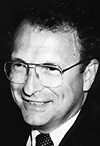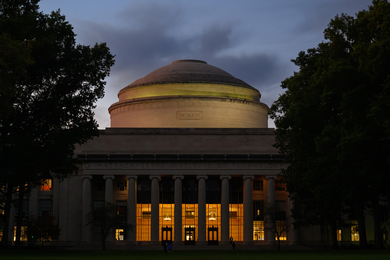James D. Bruce, professor of electrical engineering, had to be persuaded 20 years ago that assuming responsibility for MIT's computer operations was a good career move.
Last Wednesday, when he announced his retirement as vice president for information systems ( IS ), he described his job during that time as "the most exciting thing I have done in my professional career." His retirement becomes effective June 30.
"In these 20 years, we've seen computing at MIT go from mainframes and time-shared minicomputers numbering considerably less than 100 to something like 30,000 network-attached devices on the campus," Bruce said at the IS Forum in making the announcement. "In 1983, there was no campus network; it came later. Today, none of us could think of not having essentially ubiquitous network connectivity; in fact, we only notice the network when it's not available."
Bruce noted that computing a decade from now will be as different as computing today is from what it was a decade ago. "The challenge," he said, "is what we will do with these new capabilities."
"Jim Bruce has worked tirelessly to establish MIT's ubiquitous and essential IT [information technology] environment," President Charles M. Vest said. "He also is looked to as a leader of our national university computing community, having played an essential role in key developments such as Internet2. We will miss him as a senior administrator and member of the Academic Council."
Dean for Undergraduate Education Robert P. Redwine, professor of physics, will chair the search committee for Bruce's successor. Other members to be appointed by Executive Vice President John R. Curry and Provost Robert A. Brown will be drawn from across the Institute and will include representatives from IS.
"From the Athena Project to pioneering installation of business enterprise software to his role in Internet2, Jim Bruce is known for his leadership in information technology among universities and beyond. We will miss him, but always with the knowledge that he will be there to help with the knotty problems if we ask," Curry said.
Bruce, a graduate of Lamar State College of Technology in his native Texas, received the S.M. from MIT in 1960 and the Sc.D. in 1964. He joined the faculty in 1964 and became associate professor four years later. He was promoted to full professor in 1973.
Bruce was executive officer of electrical engineering and computer science from 1969-71, when he became associate dean of the School of Engineering and served as its dean in 1977-78. The next year, he was appointed director of the Industrial Liaison Program. In this role, he guided the expansions of programs with companies in the Far East, Europe and Latin America. He was appointed director of Information Systems in 1983 and vice president three years later.
From 1972-77, Bruce and his family were senior faculty in residence at Burton-Conner House. He received the Gordon Y Billard Award in 1978 for "untiring contributions to MIT in administration, engineering education and devotion to students."
A decade ago, Bruce was instrumental in the formation of NEARnet, the initial academic and research network for the New England states. He was a founding member of the board of trustees of the Consortium for Scientific Computing, which operated the John von Neumann Center, one of the original National Science Foundation supercomputer facilities. From 1999 to April 2002, he chaired the Network Planning and Policy Advisory Committee for Internet2, and was a member of the board of trustees for the University Corporation for Advanced Internet Development.
Bruce is an active member of Park Street Church, where he serves in many capacities. He and his wife Eleanor live in Lexington. They have three children and nine grandchildren.
A version of this article appeared in MIT Tech Talk on December 11, 2002.






